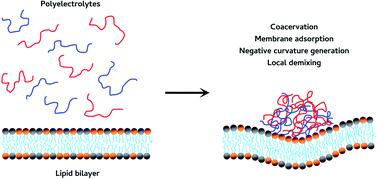当前位置:
X-MOL 学术
›
Chem. Sci.
›
论文详情
Our official English website, www.x-mol.net, welcomes your feedback! (Note: you will need to create a separate account there.)
Coacervation of poly-electrolytes in the presence of lipid bilayers: mutual alteration of structure and morphology
Chemical Science ( IF 8.4 ) Pub Date : 2022-06-16 , DOI: 10.1039/d2sc02013k Sayantan Mondal 1 , Qiang Cui 1, 2, 3
Chemical Science ( IF 8.4 ) Pub Date : 2022-06-16 , DOI: 10.1039/d2sc02013k Sayantan Mondal 1 , Qiang Cui 1, 2, 3
Affiliation

|
Many intrinsically disordered peptides have been shown to undergo liquid–liquid phase separation and form complex coacervates, which play various regulatory roles in the cell. Recent experimental studies found that such phase separation processes may also occur at the lipid membrane surface and help organize biomolecules during signaling events; in some cases, phase separation of proteins at the membrane surface was also observed to lead to significant remodeling of the membrane morphology. The molecular mechanisms that govern the interactions between complex coacervates and lipid membranes and the impacts of such interactions on their structure and morphology, however, remain unclear. Here we study the coacervation of poly-glutamate (E30) and poly-lysine (K30) in the presence of lipid bilayers of different compositions. We carry out explicit-solvent coarse-grained molecular dynamics simulations by using the MARTINI (v3.0) force-field. We find that more than 20% anionic lipids are required for the coacervate to form stable contact with the bilayer. Upon wetting, the coacervate induces negative curvature to the bilayer and facilitates local lipid demixing, without any peptide insertion. The magnitude of negative curvature, extent of lipid demixing, and asphericity of the coacervate increase with the concentration of anionic lipids. Overall, we observe a decrease in the number of contacts among the polyelectrolytes as the droplet spreads over the bilayer. Therefore, unlike previous suggestions, interactions among polyelectrolytes do not constitute a driving force for the membrane bending upon wetting by the coacervate. Rather, analysis of interaction energy components suggests that bending of the membrane is favored by enhanced interactions between polyelectrolytes with lipids as well as with counterions. Kinetic studies reveal that, at the studied polyelectrolyte concentrations, the coacervate formation precedes bilayer wetting.
中文翻译:

脂质双层存在下聚电解质的凝聚:结构和形态的相互改变
许多本质上无序的肽已被证明会经历液-液相分离并形成复杂的凝聚层,在细胞中发挥各种调节作用。最近的实验研究发现,这种相分离过程也可能发生在脂质膜表面,并有助于在信号事件期间组织生物分子;在某些情况下,还观察到膜表面蛋白质的相分离导致膜形态的显着重塑。然而,控制复杂凝聚层和脂质膜之间相互作用的分子机制以及这种相互作用对其结构和形态的影响仍不清楚。在这里,我们研究了在不同组成的脂质双层存在下聚谷氨酸(E 30)和聚赖氨酸(K 30 )的凝聚。我们使用 MARTINI (v3.0) 力场进行显式溶剂粗粒度分子动力学模拟。我们发现凝聚层需要超过 20% 的阴离子脂质才能与双层形成稳定的接触。润湿后,凝聚层会引起双层的负曲率,并促进局部脂质分层,而无需插入任何肽。负曲率的大小、脂质分层的程度和凝聚层的非球面度随着阴离子脂质的浓度而增加。总体而言,我们观察到随着液滴在双层上扩散,聚电解质之间的接触数量减少。因此,与之前的建议不同,聚电解质之间的相互作用并不构成在凝聚层润湿时膜弯曲的驱动力。相反,对相互作用能量成分的分析表明,聚电解质与脂质以及抗衡离子之间的相互作用增强有利于膜的弯曲。动力学研究表明,在所研究的聚电解质浓度下,凝聚层形成先于双层润湿。
更新日期:2022-06-16
中文翻译:

脂质双层存在下聚电解质的凝聚:结构和形态的相互改变
许多本质上无序的肽已被证明会经历液-液相分离并形成复杂的凝聚层,在细胞中发挥各种调节作用。最近的实验研究发现,这种相分离过程也可能发生在脂质膜表面,并有助于在信号事件期间组织生物分子;在某些情况下,还观察到膜表面蛋白质的相分离导致膜形态的显着重塑。然而,控制复杂凝聚层和脂质膜之间相互作用的分子机制以及这种相互作用对其结构和形态的影响仍不清楚。在这里,我们研究了在不同组成的脂质双层存在下聚谷氨酸(E 30)和聚赖氨酸(K 30 )的凝聚。我们使用 MARTINI (v3.0) 力场进行显式溶剂粗粒度分子动力学模拟。我们发现凝聚层需要超过 20% 的阴离子脂质才能与双层形成稳定的接触。润湿后,凝聚层会引起双层的负曲率,并促进局部脂质分层,而无需插入任何肽。负曲率的大小、脂质分层的程度和凝聚层的非球面度随着阴离子脂质的浓度而增加。总体而言,我们观察到随着液滴在双层上扩散,聚电解质之间的接触数量减少。因此,与之前的建议不同,聚电解质之间的相互作用并不构成在凝聚层润湿时膜弯曲的驱动力。相反,对相互作用能量成分的分析表明,聚电解质与脂质以及抗衡离子之间的相互作用增强有利于膜的弯曲。动力学研究表明,在所研究的聚电解质浓度下,凝聚层形成先于双层润湿。



























 京公网安备 11010802027423号
京公网安备 11010802027423号